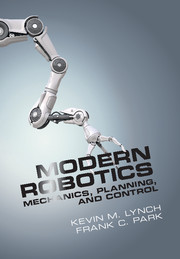Book contents
- Frontmatter
- Contents
- Foreword by Roger Brockett
- Foreword by Matthew Mason
- Preface
- 1 Preview
- 2 Configuration Space
- 3 Rigid-Body Motions
- 4 Forward Kinematics
- 5 Velocity Kinematics and Statics
- 6 Inverse Kinematics
- 7 Kinematics of Closed Chains
- 8 Dynamics of Open Chains
- 9 Trajectory Generation
- 10 Motion Planning
- 11 Robot Control
- 12 Grasping and Manipulation
- 13 Wheeled Mobile Robots
- A Summary of Useful Formulas
- B Other Representations of Rotations
- C Denavit–Hartenberg Parameters
- D Optimization and Lagrange Multipliers
- Bibliography
- Index
7 - Kinematics of Closed Chains
Published online by Cambridge University Press: 04 June 2024
- Frontmatter
- Contents
- Foreword by Roger Brockett
- Foreword by Matthew Mason
- Preface
- 1 Preview
- 2 Configuration Space
- 3 Rigid-Body Motions
- 4 Forward Kinematics
- 5 Velocity Kinematics and Statics
- 6 Inverse Kinematics
- 7 Kinematics of Closed Chains
- 8 Dynamics of Open Chains
- 9 Trajectory Generation
- 10 Motion Planning
- 11 Robot Control
- 12 Grasping and Manipulation
- 13 Wheeled Mobile Robots
- A Summary of Useful Formulas
- B Other Representations of Rotations
- C Denavit–Hartenberg Parameters
- D Optimization and Lagrange Multipliers
- Bibliography
- Index
Summary
Any kinematic chain that contains one or more loops is called a closed chain. Several examples of closed chains were encountered in Chapter 2, from the planar four-bar linkage to spatial mechanisms like the Stewart–Gough platform and the Delta robot (Figure 7.1). These mechanisms are examples of parallel mechanisms: closed chains consisting of fixed and moving platforms connected by a set of “legs.” The legs themselves are typically open chains but sometimes can also be other closed chains (like the Delta robot in Figure 7.1(b)). In this chapter we analyze the kinematics of closed chains, paying special attention to parallel mechanisms.
The Stewart–Gough platform is used widely as both a motion simulator and a six-axis force–torque sensor. When used as a force–torque sensor, the six prismatic joints experience internal linear forces whenever any external force is applied to the moving platform; by measuring these internal linear forces one can estimate the applied external force. The Delta robot is a three-dof mechanism whose moving platform moves in such a way that it always remains parallel to the fixed platform. Because the three actuators are all attached to the three revolute joints of the fixed platform, the moving parts are relatively light; this allows the Delta to achieve very fast motions.
Closed chains admit a much greater variety of designs than open chains, and their kinematic and static analysis is consequently more complicated. This complexity can be traced to two defining features of closed chains: (i) not all joints are actuated, and (ii) the joint variables must satisfy a number of loop-closure constraint equations, which may or may not be independent depending on the configuration of the mechanism. The presence of unactuated (or passive) joints, together with the fact that the number of actuated joints may deliberately be designed to exceed the mechanism's kinematic degrees of freedom – such mechanisms are said to be redundantly actuated – not only makes the kinematics analysis more challenging but also introduces new types of singularities not present in open chains.
Recall also that, for open chains, the kinematic analysis proceeds in a more or less straightforward fashion, with the formulation of the forward kinematics (e.g., via the product of exponentials formalism) followed by that of the inverse kinematics.
- Type
- Chapter
- Information
- Modern RoboticsMechanics, Planning, and Control, pp. 209 - 230Publisher: Cambridge University PressPrint publication year: 2017



